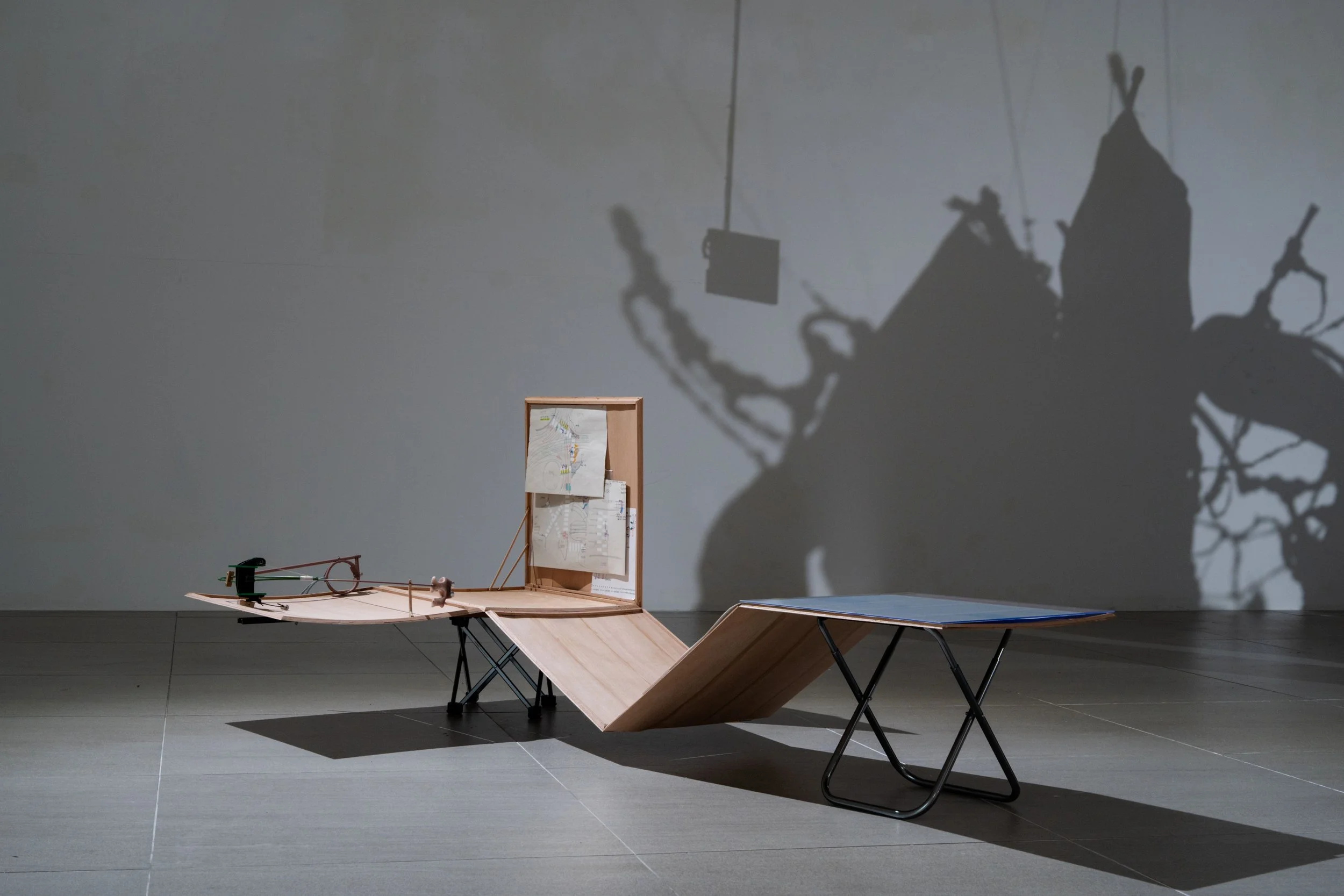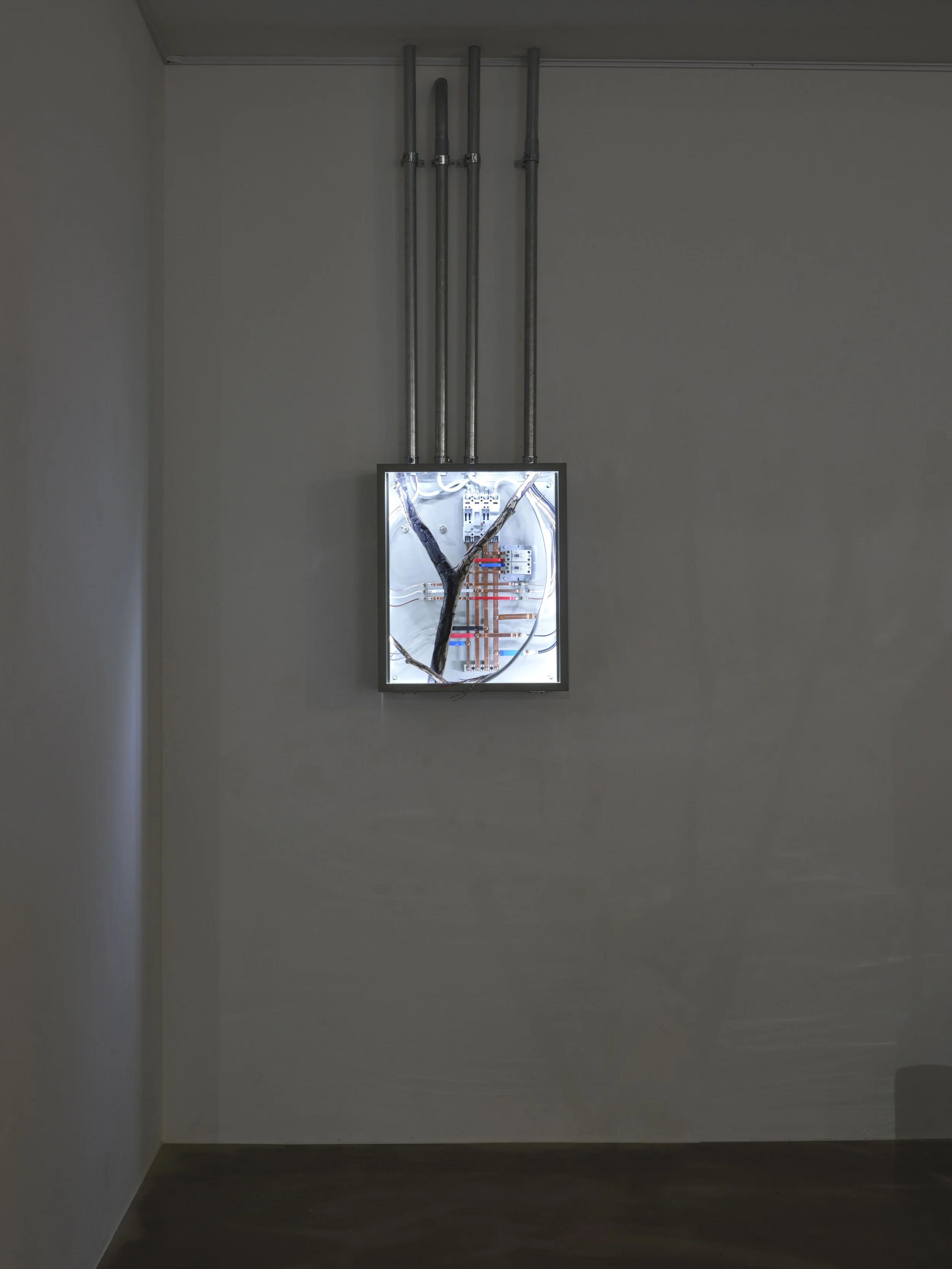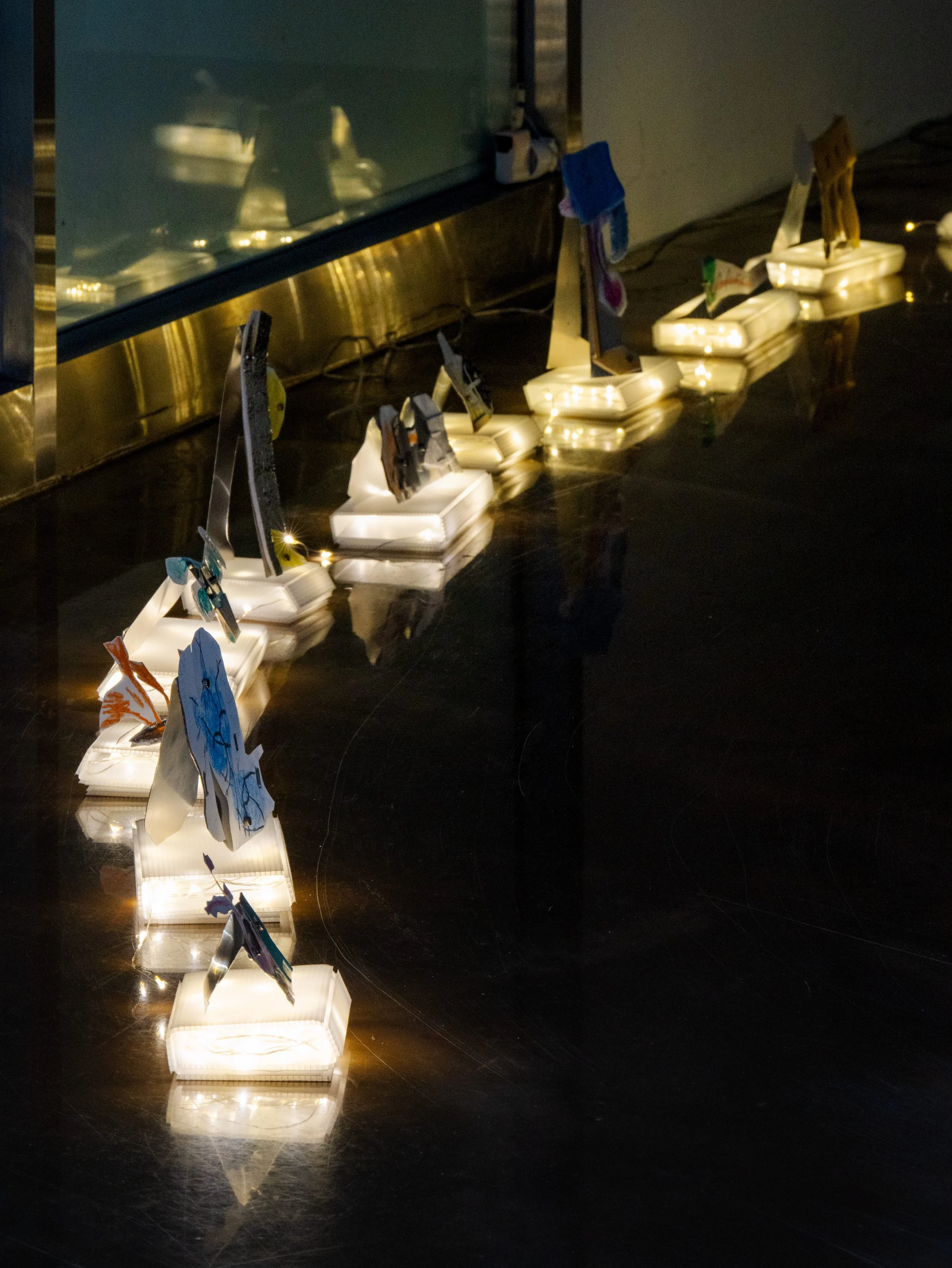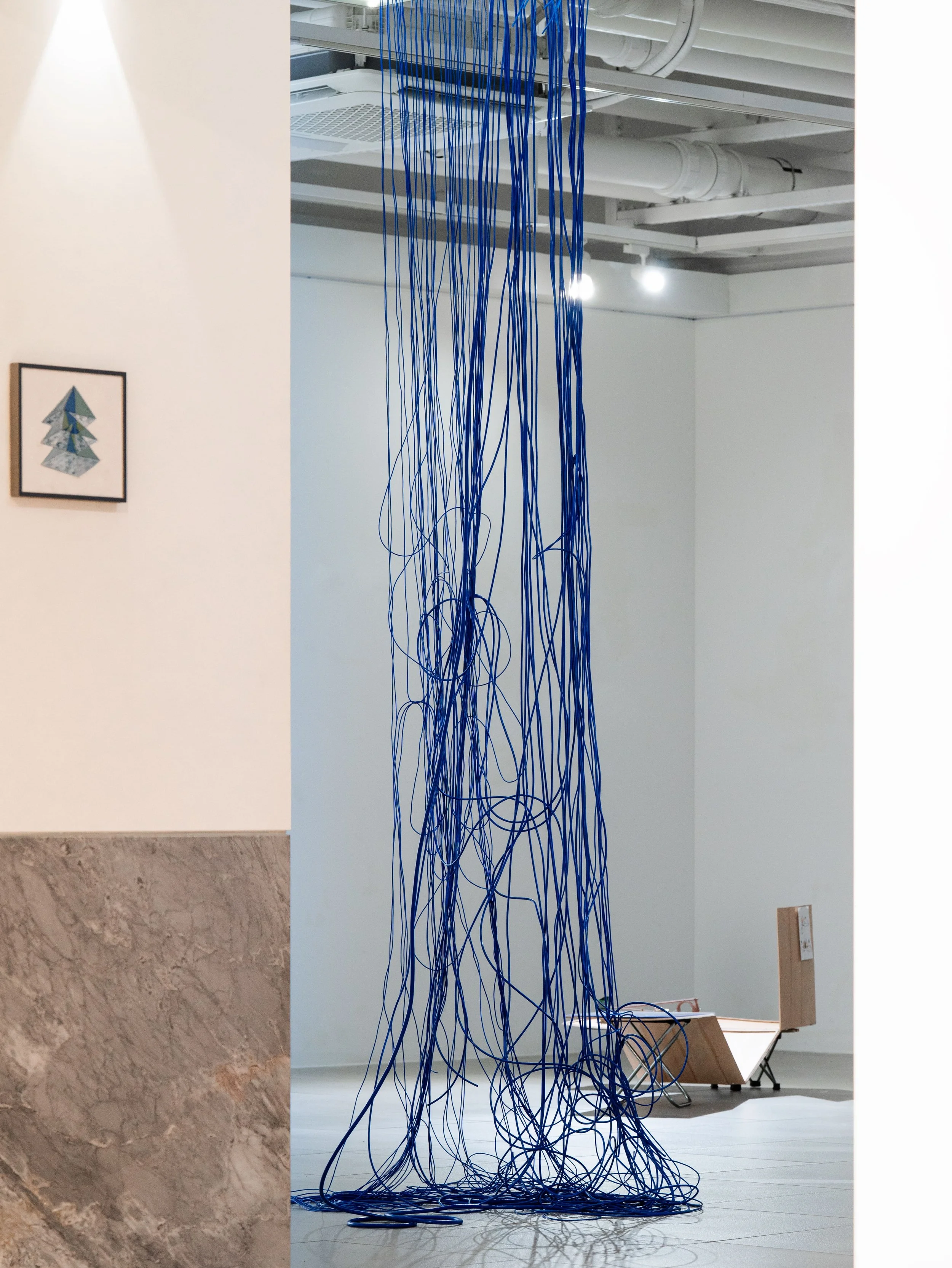Infiltrators
침입자들
27 August - 26 October, 2025
SAPY, Seoul
Participating artists: Sojin Kwak, Jisu Kim, Lee Dong-hyun, Jooyeon Lee, Haryung Lee
Graphic design by Buldozzer
Photography by Euirock Lee, Hyojin Lim
《침입자들》은 도시의 기반 시설을 이용하거나 거부하는, 이에 개입하거나 기생하는, 때로는 오염시켜 전환하는 다종다양한 몸들을 소환하여 우리를 둘러싼 환경의 회로를 재배치하는 시도다. 특히, 이미 유구한 역사와 첨예한 이해관계에 의해 체결된 약속들을 물려받은, 미완의 상태이자 성장이 기대되는 존재로 규정되곤 하는 ‘청년’ 세대 창작자 5인과 함께 하기로 한다. 영상, 사운드, 평면, 설치 등 다양한 매체를 가로질러 창작을 이어가는 이들은 주어진 환경을 비스듬 관찰하고, 비생산적인 행위와 우회적인 언어를 통해 일견 견고해 보이는 세계를 등 돌리거나 끌어안는다. 나아가 이들은 정상 범주에서 탈락된 감각과 인간-비인간-사물의 집합체의 낯선 움직임을 경유하여 도시가 이 세대에게 부여했거나 하지 않은 자리를 더듬어본다.
젠더와 인종, 장애 유무 등 여러 축의 매트릭스에서 주변화된 몸은 현대 사회의 공적 공간에 출입하고 자원을 사용할 권한을 갖지만, 특정 신체 유형이 ‘자연스러운’ 점유자로 설정되어 있기에 여전히 암묵적으로는 무단 침입자로 취급된다. 이처럼 신체와 공간이 서로 집요하게 들러붙어 있다면, 원칙상 ‘누구에게나 열린 공간’은 실은 ‘보편적’인 인간을 위한 자리에 다름 아닐 것이다. 그렇다면 내부자이자 동시에 이질적인 존재인 ‘공간 침입자들’이야말로 우리의 환경을 성찰하는 출발점이 되어야 할 것이다.[1] 한편, 대도시의 청년은 이 사회를 일구어갈 미래의 주인공이자 가장 활발한 유동 인구로 간주된다. 교차적 정체성과 차이를 지우고 단일한 집단으로 환원된 청년 세대는 소비와 생산의 주역, 즉 도시의 연료로 식별되는 동시에 안정적인 주거 및 근무 환경은 보장받지 못하는 이중 구속에 놓여 있다.
중심이자 주변, 내부자이자 외부자로서의 양가성을 해소하기보다 동력 삼기로 한 이 전시의 ‘침입자들’은 일면 매끈하게 펼쳐진 도시 곳곳에서 크고 작은 오작동을 발견한다. ‘모두’의 편의를 위해 마련된 장치가 ‘나’와 ‘우리’를 배신할 때, 침입자들은 개선을 도모하기보다 규범을 벗어난 몸을 자처하거나 재구성하여 도시에 재접속한다. 인프라스트럭처의 실패 앞에서 그것이 무한히 발전할 수 있다는 환상에 도전하며, 이를 오히려 창조적인 생산의 기회로 삼는다.[2]
그 과정은 실패를 가속하는 모습을 띨지도 모른다. 인간을 도구화하는 시스템에 기계와 밀착된 몸을 내맡기기, 정해진 규격 대신 유기적인 신체를 기준 삼기, 불안정한 조건을 변덕스럽고 산만하게 관통하기, 사물의 구동 방식을 부러 오인하기, 서로를 이해하지 못한 채 몸을 맞대기. 이러한 것들이 잠정적인 전술이 되어줄 것이다. 역사와 문화권을 가로질러 ‘우리’의 자리를 주장하는 행위는 엇비슷한 양상을 보인다. 바르게 서기보다는 눕거나 앉아 통행을 방해하기, 그리고 시설을 본래 용도와 다르게 전유하기. 이러한 몸의 사용은 그 자체로 메시지가 되어 공간에 새겨진다.[3]
2020년 설립된 서울문화재단의 청년예술청은 청년예술을 증진하기 위한 물리적인 공간과 지원 사업 등으로 구성된 인프라스트럭처다. 그중 입구에 펼쳐진 공유 오피스는 아무것도 구매하지 않고도 자리를 차지할 수 있는, 도시 속에서 갈수록 찾아보기 어려운 개방 공간이다. 이 전시는 개방 공간과 맞닿아 있는 화이트갤러리를 임시로 점유하되, 주어진 환경에 개입을 최소화하여 이 공간과 적극적으로 얽히기로 한다. 한때 라운지 공간이었던 곳을 갤러리로 확장한 흔적과 다각적 사용을 염두에 둔 접이식 가벽, 회의실로 향하는 통로로서의 역할 등을 유지하고, 별도 가벽이나 집기를 도입하지 않는다. ‘침입자들’은 화이트큐브도 블랙박스도 아닌 이곳에 한시적으로 점유한다는 조건을 기꺼이 수용하되 경계를 늦추지 않기로 한다.
[1] 너멀 퓨워, 『공간 침입자: 중심을 교란하는 낯선 신체들』, 김미덕 역, 서울: 현실문화, 2004/2017, 23.
[2] Lauren Berlant, On the Inconvenience of Other People, Durham & London: Duke University Press, 2022, 21.
[3] 김현경, 『사람, 장소, 환대』, 서울: 문학과지성사, 2015, 285.
Infiltrators seeks to rewire the circuits of our shared environment by summoning bodies that use or refuse, intervene in or parasite upon, and at times contaminate and transform the city’s infrastructures. The exhibition gathers five young artists—often labeled “emerging,” yet weighed down by inherited contracts shaped by long histories and conflicting interests. Working across moving image, sound, drawing, and installation, they look at their surroundings askew and respond with unproductive gestures and oblique languages, resisting—or at times embracing—a world that seems already predetermined. In doing so, they trace the unstable positions their generation is granted—or denied—through abjected sensations and the uncanny movements of human–nonhuman–thing assemblages.
Bodies marginalized along axes of gender, race, and disability may formally hold the right to enter public space and use shared resources, yet they are still tacitly cast as trespassers whenever a particular kind of body is presumed to be the “natural” occupant. If bodies and spaces are bound so insistently, then what is called a space “open to all” is, in effect, a space reserved for the so-called universal human. It is the infiltrators—at once insiders and outsiders, what Nirmal Puwar has named “space invaders”—who must become the starting point for reflecting on our environments.[1] At the same time, the younger generation in metropolises is rarely considered marginalized. They are cast as the protagonists of society’s future, celebrated as its most mobile and adaptable population. Yet once reduced to a single homogeneous group, their intersecting identities and differences erased, they too are caught in a double bind: marked as the very fuel of the city—agents of both consumption and production—while denied stable housing and working conditions.
The infiltrators in this exhibition embrace—rather than resolve—the ambivalence of being both central and peripheral, insiders and outsiders. They trace small and large malfunctions across the city’s seemingly seamless surfaces. When infrastructures designed for the convenience of “everyone” betray us, infiltrators do not step in to repair them. Instead, they claim and reconfigure bodies that fall outside the norm. Confronting infrastructural breakdowns, they refuse the fantasy of infinite progress and seize failure as a chance for generative practice.[2]
This process may even look like an acceleration of failure: yielding the body to machines within systems that instrumentalize humans; taking the organic body as measure rather than standardized dimensions; moving through precarious conditions with a capricious, wayward rhythm; willfully misreading how common apparatus operate; supporting one another’s bodies however unaligned. Such gestures, at least provisionally, become tactics. Across histories and cultural contexts, acts of claiming a place of one’s own have taken similar forms: lying down or sitting to obstruct passage rather than standing upright, or appropriating facilities against their prescribed use. These uses of the body inscribe their own messages directly into space.[3]
Established in 2020 by the Seoul Foundation for Arts and Culture, Seoul Artists’ Platform_New&Young (SAPY) is an infrastructure of physical spaces and support programs designed to foster young artistic practices. At its entrance is a shared office—an increasingly rare open space in the city where one can occupy a seat without having to buy anything. This exhibition temporarily occupies the White Gallery adjoining this office, engaging actively with its given conditions while minimizing intervention. It preserves the traces of the lounge that the gallery once was, the foldable partition walls devised to accommodate multiple uses, and the corridor function that connects to the meeting rooms, without introducing additional structures or furnishings. Infiltrators accepts the condition of occupying, only for a limited time, a space that is neither white cube nor black box—while refusing to let down its guard.
[1] Nirmal Puwar, Space Invaders: Race, Gender and Bodies Out of Place, trans. Kim Mideok (Seoul: Hyunsil Munhwa, 2004/2017), 23.
[2] Lauren Berlant, On the Inconvenience of Other People, Durham & London: Duke University Press, 2022, 21.
[3] Hyunkyung Kim, Saram, Jangso, Hwandae [Person, Place, Hospitality] (Seoul: Moonji Publications, 2015), 285.









